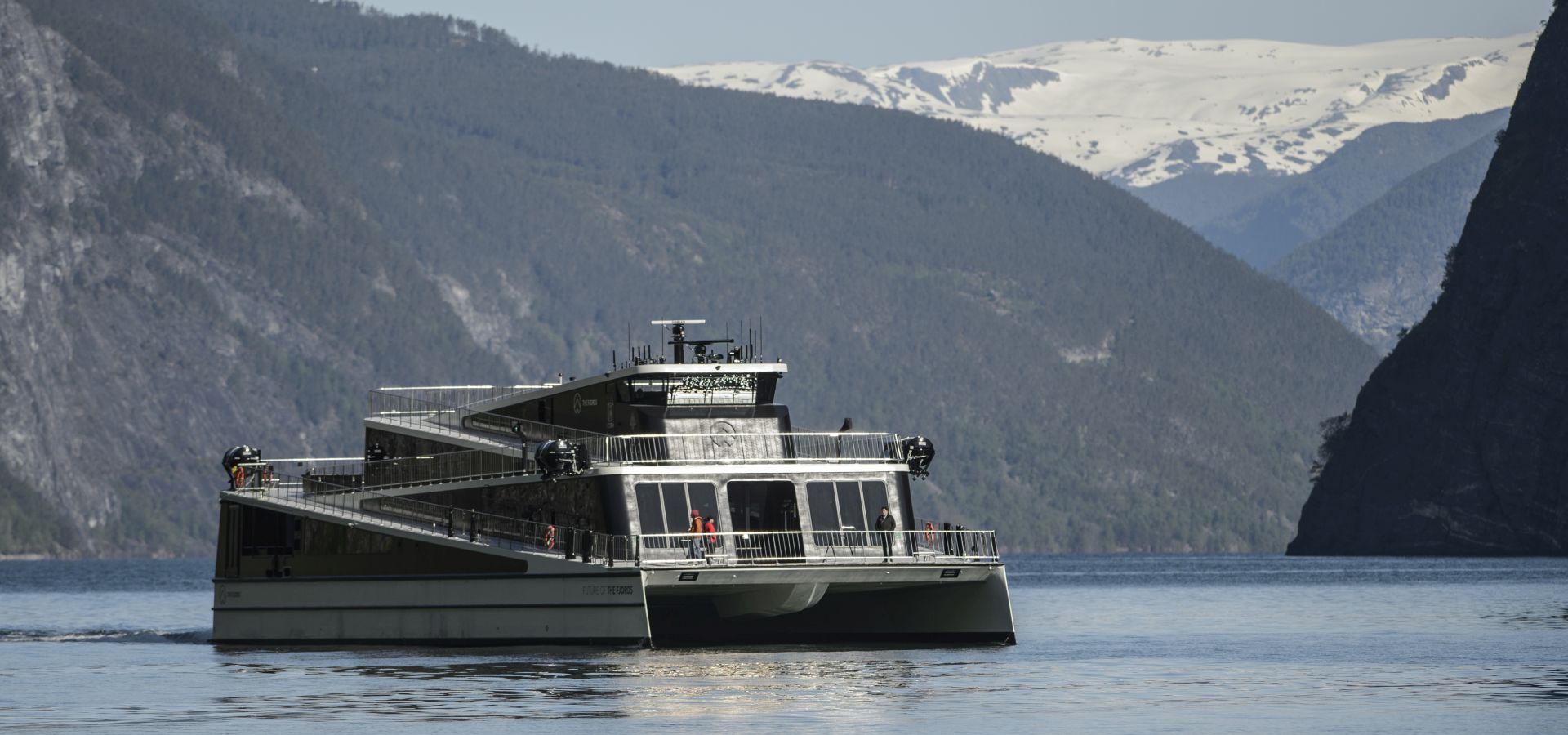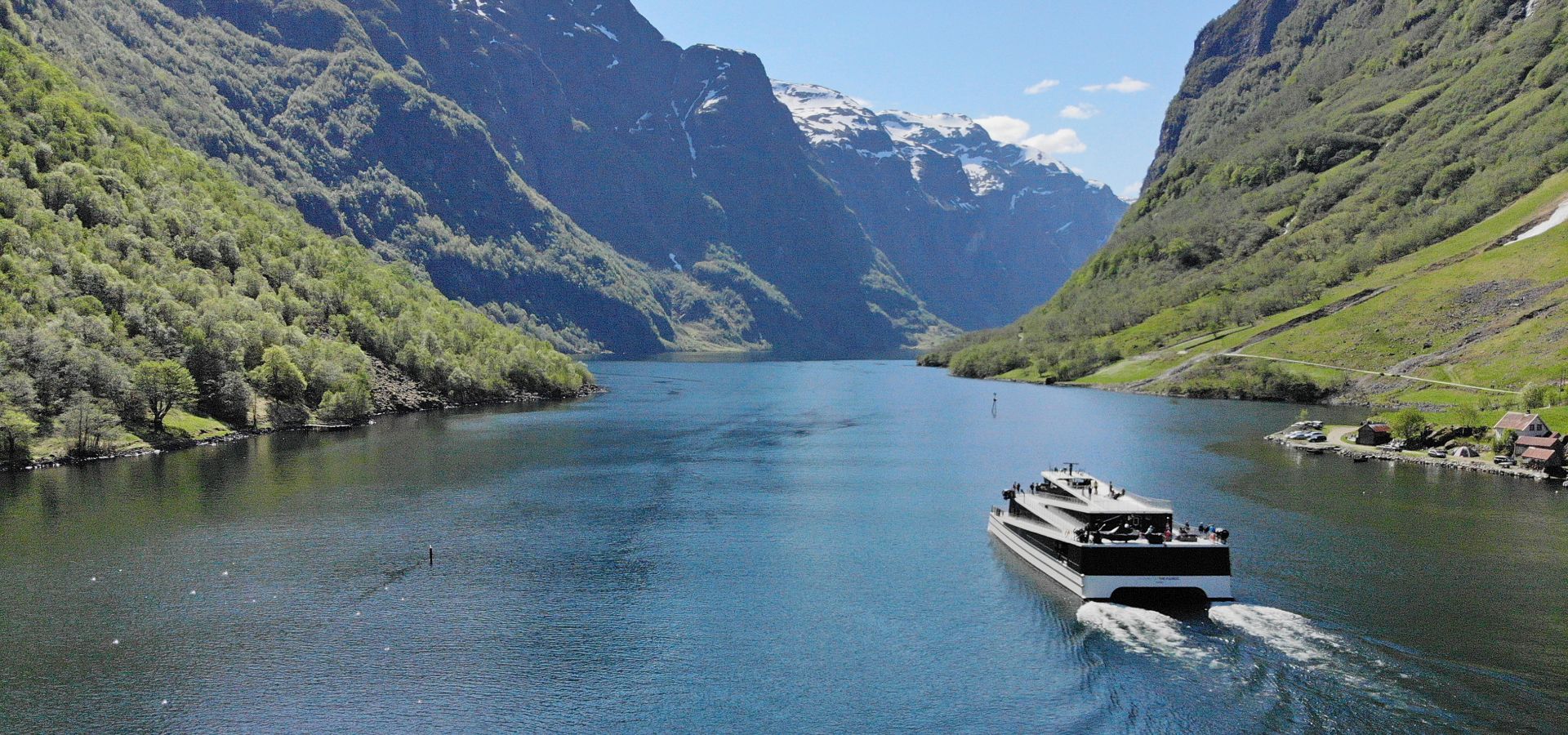Until now, exploring Norway’s jaw-dropping fjords by the sea has meant sinning – in a big way. Cruise ships are terrible for the environment. But the new battery-powered passenger ship Future of the Fjords promises a cleaner future, says Paul Hockenos.

The battery-powered passenger ship Future of the Fjords (Photo by Peter Tubaas, NCE Maritime CleanTech, CC BY-SA 4.0)
The giant cruise ships that ply the 2000-plus kilometer western coast and penetrate deep into its interior through the glacier-carved saltwater fjords are egregious polluters, not just of greenhouse gases but also of sulfur and nitrogen oxides, the carcinogenic ingredients of smog. On summer days, the diminutive ports nestled deep below the towering peaks that shoot up from the fjords can be thickly enveloped in a pall of acrid haze. Even the smaller tourist vessels that depart from the port city of Bergen and other coastal towns on shorter forays run on diesel, which is considered clean energy compared to the heavy fuel oil or other “bunker fuels” that the enormous cruise liners burn. Of course, diesel is not clean, just considerably less filthy than bunker fuels.
But Norway is transforming the world of shipping, and the future has already arrived, at least a glimpse of it, in the battery-powered passenger ship called Future of the Fjords. The Future, as its crew calls it, is a 42-meter, battery-propelled catamaran crafted out of lightweight carbon-fiber composite that can ferry as many as 400 people through some of Norway’s most spectacular fjords. Just from inspecting the Norwegian designed and constructed product, you wouldn’t think that it carries 5,500 kilos of battery in its raised dual hulls, which are charged with 100-percent-clean Norwegian electricity (the country’s power supply hails almost exclusively from hydroelectric plants located in its prodigious mountains.)
The Future alone cannot yet rival the likes of the Norwegian cruise colossus, Hurtigruten, whose liners can ferry several thousand people in week-long voyages to the Polar Rim – for which they require motors larger than two houses. But the three-hour trips between the villages of Flåm and Gudvangen, the latter in a UNESCO World Heritage Site, is among the most spectacular corners of all of the fjords. Abroad the angular, squared-hulled craft one experiences a treat the quality of which the cruise ships can’t begin to match.
For one, its electric motors are virtually soundless, in contrast to the liners’ ginormous drive-train engines. Rather than rumble, it glides. And the absence of smoke-stack emissions makes viewing from its base decks or the higher decks an incomparable delight. As the captain backed us up to a majestic waterfall pouring into the Aurlandsfjord, one woman exclaimed, “You can actually smell the waterfalls!”

The Future of the Fjords can be charged with 100-percent-clean Norwegian electricity
The Norwegians aren’t alone in the field of electric seafaring, but they are out in front, and the jump might prove lucrative as the first generation of battery-run ships in Norway, as well as the other Nordic countries and the Netherlands, have proved easier than expected. Norway is now ready to turn all of its ferries electric, which should happen in the next six years. A fleet of new electric ferries are currently in production, but older ones can be retrofitted surprisingly quickly: the engine rooms of the vessels are about the size necessary to hold several thousand kilos of batteries. With each new fleet, the batteries will get smaller and cheaper, say the entrepreneurs – hopefully the way solar PV models did, although such a steep trajectory is currently wishful thinking.
Nevertheless, it’s fair to say that the long overdue revolution in shipping has begun. Indeed, until now shipping has been a sorry laggard: the sector isn’t even covered in the Paris treaty, so hard did the industry’s lobbies battle to exempt it. But the International Maritime Organization (IMO), the UN specialized agency responsible for shipping, now has formulated its own climate protection agenda, which though hardly adequate in itself, is a start. It envisions reducing CO2 emissions across international shipping by at least 40% by 2030, and 70% by 2050, compared to 2008. Also, by 2025 new ships should be (it’s all nonbinding, mind you) 30% more energy efficient than those built in 2014. Shipping is one component of the global transportation sector that is responsible for the sector’s rapidly rising emissions.
The bad news for fjord tourists is that The Future is nearly alone at the moment. Norway’s first pilot e-ship was a car ferry that began sailing sorties of just a few kilometers in 2015 – and has ever since, 36 times a day. Its success after a couple of rounds of adjustments sparked the interest that will, claim its proponents, transform the face of shipping in the not too distant future.
The cruise liners and cargo ships with their loads and long distances will require significantly more powerful batteries. Nevertheless, Hurtigruten has hybrids liners operating on diesel and LNG, the latter which is cleaner than diesel but, of course, still a fossil fuel.
The cruise companies had better hurry because by 2026 access to the World Heritage Site fjords will be restricted, by Norwegian law, to zero-emission vessels. Four years later, Norway will restrict other Norwegian waters to ships with low- or zero-emission technology.
So, sin or sail? Go with The Future for now and have patience: a revolution in shipping is underway.